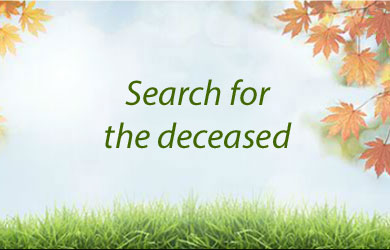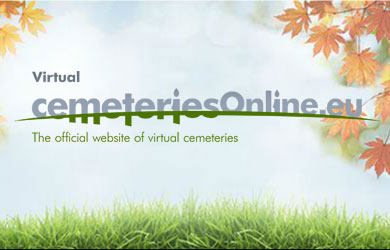- Evolution of burial tradition in Europe
- Evolution of burial tradition in Slovak Republic
- Slovak folk gravestones
- Present state of burials in Slovak Republic
- Building burial places presently in Europe
- Common present trends in grave arrangements
- Setting up plants on graves
- Photo gallery
Evolution of burial tradition in Europe
One of the oldest evidence which gives information to present society about our civilisation are burial places. First early sepulchre architecture in neolithic period is represented by megalith graves. Perhaps most famous sepulchre constructions in history are royal chambers in Egypt – pyramids and rock monuments in „Valley of the Kings“. Old romans have founded a social burial system. Burial organisation took care of burying poorest people into so called columbariums. Usually, they have positioned two urns with ash in one apse of columbarium. Further, old romans have started burying bodies of deceased in catacombs, which were under surface burial places. This was the step from burning bodies to burying them as a whole in 2nd century AC. Burial of whole bodies has started to dominate due to influence of Christianity in whole Europe, because of belief in resurrection. As burial places were choosen either churches (temples, monkeries) or consecrated ground around them after the Christianity was formally accepted by the society.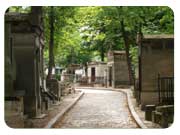 Considerable changes in burying has started in the time of Enlightenment, when cemeteries surrounding churches were closed due to sanitation reasons. In the year of 1765 AD in France, Paris’s parliament has stated, that all of cemeteries in Paris had to relocate outside of the city. On the new built cemeteries in Paris, there was multi class system of positioning graves invented. Division of cemetery’s area was even, monumental graves were located next to alleys and other-simpler graves were creating grave fields. Great curiosities were crematories intended for burning deceased body, which were in the 19th century understood as antireligious. Cemeteries from this period have become a foundation of later built european cemeteries. Well known Pére Lachaise cemetery form these times is located in Paris, France and was opened in 1807.
Considerable changes in burying has started in the time of Enlightenment, when cemeteries surrounding churches were closed due to sanitation reasons. In the year of 1765 AD in France, Paris’s parliament has stated, that all of cemeteries in Paris had to relocate outside of the city. On the new built cemeteries in Paris, there was multi class system of positioning graves invented. Division of cemetery’s area was even, monumental graves were located next to alleys and other-simpler graves were creating grave fields. Great curiosities were crematories intended for burning deceased body, which were in the 19th century understood as antireligious. Cemeteries from this period have become a foundation of later built european cemeteries. Well known Pére Lachaise cemetery form these times is located in Paris, France and was opened in 1807.
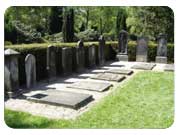 Under the influence of romanism, in the middle of 19th century there was inclination more into park or country style shaping of cemetery‘s areas. In Europe, the first park style cemetery Ohlsdorf was opened in Hamburg, Germany. In years 1897 – 1913 the cemetery’s area around 400 ha = 988,42 acres was arranged by J.W.Cordes (1840 – 1917) as a natural park into which grave fields were scattered.
Under the influence of romanism, in the middle of 19th century there was inclination more into park or country style shaping of cemetery‘s areas. In Europe, the first park style cemetery Ohlsdorf was opened in Hamburg, Germany. In years 1897 – 1913 the cemetery’s area around 400 ha = 988,42 acres was arranged by J.W.Cordes (1840 – 1917) as a natural park into which grave fields were scattered. A new reform movement arose around 1900 in Germany. It was recalling to be simpler when creating gravestones, which should express decorous death. With this thought in mind, a forest cemetery in Munich was founded in the year of 1907. The forest was understood as a narutal chapel. Simplicity of gravestones was required here. Fair conditions for founding and improving forest cemeteries were in 19th century in Sweden. Nordern woody land, inhabitants binded together with nature and influence of romanism – all of these aspects has contributed to start a new era of forest cemeteries. Most famous cemetery of this type was built in years 1915 – 1940 is in Ensked by Stockholm.
Evolution of burial tradition in Slovak Republic
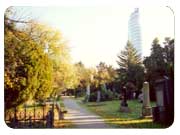 In 8th century, south-west part of Slovak Republic was mostly inhabited by citizens, which weren’t burning bodies of their deceased, but were burying them. This was the result of gradual increase of Christianity in whole Europe. Slavics (Slavic nation citizens) marked their graves with big rocks, mainly by head and feet. These rocks were named „sorrowies“ (sorrow stones). Buryied bodies were layed in the grave in such a way, that their feet were oriented to the east, which was related to the cult of the Sun. Paganish habits were constrained with the spread of Christianity and also burying around churches according to sacral rules was more in common. For the first time already in 16th century, there was a request to locate new cemeteries outside of towns and cities. Final decision about relocating cemeteries in Slovak Republic has come with the law in 1876. It has prohibited building new cemeteries around new built churches in the center of towns and cities. Evolution of bigger town cemeteries in Slovak Republic is in detail known especially by the history of Bratislava city, which by its greatness and intercultureness has given a space for creating more cemeteries particularly catholic, lutheran and jewish. Also, in 18th century in Bratislava a request of relocating burials outside of the city has arose. Because of this reason the town hall of Bratislava has published in 1742 a note which has further prohibited burials on the cemeteries inside of the city. A great success was opening Saint Ondrej’s cemetery (Ondrej’s cemetery) in 1784, which has become a last-resting place for prominents representing science, culture and social life in the period of time form end of 18th until mid 20th century. In present time, Ondrej’s cemetery serves as a green area with remaining sorrow spirit, but also intented for relaxing. The first crematory in former Austrian-Hungarian empire was built in 1916 in the city of Liberec and started to work in 1918. Fourteen new crematories were built In the territory of Bohemia and Moravia soon after estabilishment of Czechoslovakia. In Slovakian part of Czechoslovakia, development of crematories has started after II.world war. The first crematory was built in Bratislava – Lamac in 1968.
In 8th century, south-west part of Slovak Republic was mostly inhabited by citizens, which weren’t burning bodies of their deceased, but were burying them. This was the result of gradual increase of Christianity in whole Europe. Slavics (Slavic nation citizens) marked their graves with big rocks, mainly by head and feet. These rocks were named „sorrowies“ (sorrow stones). Buryied bodies were layed in the grave in such a way, that their feet were oriented to the east, which was related to the cult of the Sun. Paganish habits were constrained with the spread of Christianity and also burying around churches according to sacral rules was more in common. For the first time already in 16th century, there was a request to locate new cemeteries outside of towns and cities. Final decision about relocating cemeteries in Slovak Republic has come with the law in 1876. It has prohibited building new cemeteries around new built churches in the center of towns and cities. Evolution of bigger town cemeteries in Slovak Republic is in detail known especially by the history of Bratislava city, which by its greatness and intercultureness has given a space for creating more cemeteries particularly catholic, lutheran and jewish. Also, in 18th century in Bratislava a request of relocating burials outside of the city has arose. Because of this reason the town hall of Bratislava has published in 1742 a note which has further prohibited burials on the cemeteries inside of the city. A great success was opening Saint Ondrej’s cemetery (Ondrej’s cemetery) in 1784, which has become a last-resting place for prominents representing science, culture and social life in the period of time form end of 18th until mid 20th century. In present time, Ondrej’s cemetery serves as a green area with remaining sorrow spirit, but also intented for relaxing. The first crematory in former Austrian-Hungarian empire was built in 1916 in the city of Liberec and started to work in 1918. Fourteen new crematories were built In the territory of Bohemia and Moravia soon after estabilishment of Czechoslovakia. In Slovakian part of Czechoslovakia, development of crematories has started after II.world war. The first crematory was built in Bratislava – Lamac in 1968.
Slovak folk gravestones
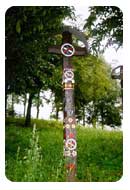 It is possible to sort types of Slovak folk gravestones into categories based upon what materials were used to build gravestones or what shape resulted form forming materials. With the first method in mind, we have four main types of materials used to create gravestones: wood, stone, metal, ceramics (rare to see). Selection of used materials mainly depended on the presence of natural resources in country around. Possibilities of forming mentioned materials have influenced gravestone’s final shapes, which were over years inspired also by religion. Crosses for example were present on Roman Catholic and Greek Catholic graves, pillars were used on Lutheran graves and stones on Jewish ones. Great alternatives of folk gravestones were created by combining different types of materials and forming them into variety of shapes. We can see, that there were differences in gravestones not only on the level of counties but even on the level of towns and villages what is a reflection of common traditions, religion and social situation and gives us important heritage value.
It is possible to sort types of Slovak folk gravestones into categories based upon what materials were used to build gravestones or what shape resulted form forming materials. With the first method in mind, we have four main types of materials used to create gravestones: wood, stone, metal, ceramics (rare to see). Selection of used materials mainly depended on the presence of natural resources in country around. Possibilities of forming mentioned materials have influenced gravestone’s final shapes, which were over years inspired also by religion. Crosses for example were present on Roman Catholic and Greek Catholic graves, pillars were used on Lutheran graves and stones on Jewish ones. Great alternatives of folk gravestones were created by combining different types of materials and forming them into variety of shapes. We can see, that there were differences in gravestones not only on the level of counties but even on the level of towns and villages what is a reflection of common traditions, religion and social situation and gives us important heritage value.
Present state of burials in Slovak Republic
The look of cemeteries in Slovak Republic has considerably changed over past decades not only in cities, but also in countryside. Authentic materials and shapes of gravestones used for hundreds of years has been interchanged for stones, concrete and automated production. Original traditions has fallen into oblivion and dignified feel of cemeteries is lost. Emotion, love and submission have faded out from gravestones. Portion of green areas is decreasing at the expense of high density grave fields needed for burying. Present design of cemeteries does not correspond with present time needs for grave arrangements and this facts result in problematic and insufficient cemetery maintenance. Present contidion of cemeteries is the result of longterm crisis of burial culture.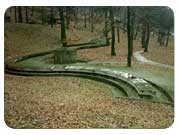 Perhaps one of the most beautiful case of modern built cemeteries in 20th century is Urn grove in Bratislava – Lamac. Together with construction of crematory buildings have started works on urn grove in natural oak and pine tree declining wooded areas. The main crematory building was designed by representative of Slovak later modern movement Ing.arch. Ferdinand Milucky and belongs to group of the most beautiful Slovakian architecture constructions.
Perhaps one of the most beautiful case of modern built cemeteries in 20th century is Urn grove in Bratislava – Lamac. Together with construction of crematory buildings have started works on urn grove in natural oak and pine tree declining wooded areas. The main crematory building was designed by representative of Slovak later modern movement Ing.arch. Ferdinand Milucky and belongs to group of the most beautiful Slovakian architecture constructions. 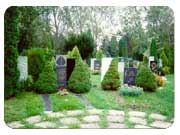 The first attempt to create park type cemetery in Slovakia is in Bratislava – Ruzinov and has been built in years 1971 – 1980. Approach used to design this cemetery has been composed of circular main roads surrounded by high greenery, which makes natural borders for grave fields of circular shape. Graves have terrain high bead and are covered mainly with grass. Usually all year or seasonal plants are planted by gravestone to complete final look of grave. Important and very positive aspect was given variety of different possible choises in gravestone’s designs. Family members are then able to choose a gravestone based upon their own taste and grave fields itself have still particular consistent character. Present state of this cemetery is negatively affected by rising density of grave fields because of a limited space.
The first attempt to create park type cemetery in Slovakia is in Bratislava – Ruzinov and has been built in years 1971 – 1980. Approach used to design this cemetery has been composed of circular main roads surrounded by high greenery, which makes natural borders for grave fields of circular shape. Graves have terrain high bead and are covered mainly with grass. Usually all year or seasonal plants are planted by gravestone to complete final look of grave. Important and very positive aspect was given variety of different possible choises in gravestone’s designs. Family members are then able to choose a gravestone based upon their own taste and grave fields itself have still particular consistent character. Present state of this cemetery is negatively affected by rising density of grave fields because of a limited space.
Building burial places presently in Europe
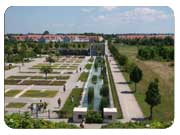 Burial places which are nowadays build in Europe still respect historical evolution of each european country and uprise from natural conditions. New cemeteries have it‘s origin either in architektonic, park type burying-grounds or in forest cemeteries, which have become present country cemeteries. One of the newest examples of how are cemeteries presently build is a country type cemetery in Nove Mesto, Slovenia. It has been built in 2000 and it’s area coveres approximately 40 ha (98.8 acres). Surface here is little undulated with uncovered rocks and authentic spruce wood. Another two new cemeteries with interesting architektonic design
Neubiberger and Riem have been opened in the year of 2000 in Munich, Germany in the area of former army airports.
Burial places which are nowadays build in Europe still respect historical evolution of each european country and uprise from natural conditions. New cemeteries have it‘s origin either in architektonic, park type burying-grounds or in forest cemeteries, which have become present country cemeteries. One of the newest examples of how are cemeteries presently build is a country type cemetery in Nove Mesto, Slovenia. It has been built in 2000 and it’s area coveres approximately 40 ha (98.8 acres). Surface here is little undulated with uncovered rocks and authentic spruce wood. Another two new cemeteries with interesting architektonic design
Neubiberger and Riem have been opened in the year of 2000 in Munich, Germany in the area of former army airports. 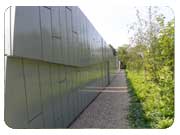 Process of renewing historical cemetery Nieuwe-Ooster in Amsterdam, Holland has started in 2001. Part of works covered restoration of two sections dedicated today for urn burials. Dominant of new built space is columbarium with distinctive zinc facade and water canal, where burials are also permited.
Process of renewing historical cemetery Nieuwe-Ooster in Amsterdam, Holland has started in 2001. Part of works covered restoration of two sections dedicated today for urn burials. Dominant of new built space is columbarium with distinctive zinc facade and water canal, where burials are also permited.
Common present trends in grave arrangements
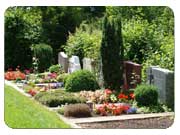 Grave arrangements in Europe are relatively diverse and interconnected with each country by specific culture and history, methods of burials and of course natural conditions. Grass cover for example is dominant on graves in northern countires. On the other hand monumental covered graves are typical for southern countries. Greatest care has been given to graves covered with plants in Germany in the time of classicism and romanism. Graves were arranged mainly with rich flower decoration. Special flowers used were annuals. This habit has influenced grave arrangement in whole Europe. When talking about present trends in design of whole cemeteries or just individual graves, we can summarize it to be simplicity and consistency. In cases where individual approach to grave arrangement was not very limited, it has brought a great variety of shapes and colours. This led to unifying grave arrangements at least inside of grave fields which are visually separated form surrounding areas. Unifying can be understood as defining gravestone’s shape, size and colour, grave‘s type and size, surface, beads, etc. It is important to retain balance between some kind of uniformity needed for a complex look of cemetery and individual approach to grave arrangement through which family members can leave a message to their loved ones.
Grave arrangements in Europe are relatively diverse and interconnected with each country by specific culture and history, methods of burials and of course natural conditions. Grass cover for example is dominant on graves in northern countires. On the other hand monumental covered graves are typical for southern countries. Greatest care has been given to graves covered with plants in Germany in the time of classicism and romanism. Graves were arranged mainly with rich flower decoration. Special flowers used were annuals. This habit has influenced grave arrangement in whole Europe. When talking about present trends in design of whole cemeteries or just individual graves, we can summarize it to be simplicity and consistency. In cases where individual approach to grave arrangement was not very limited, it has brought a great variety of shapes and colours. This led to unifying grave arrangements at least inside of grave fields which are visually separated form surrounding areas. Unifying can be understood as defining gravestone’s shape, size and colour, grave‘s type and size, surface, beads, etc. It is important to retain balance between some kind of uniformity needed for a complex look of cemetery and individual approach to grave arrangement through which family members can leave a message to their loved ones.
Setting up plants on graves
Present trends in setting up plants on graves are influenced by usual building grave’s bead in flush with surrounding terrain. It is no more common to cover whole area of grave with stone plates or to plant whole area with annuals. Before planting any flowers, we should know required plants and their characteristics, know the possibilities of combining given plants and there should be skilled gardeners to take care about it. Mentioned services are usually accessible to reach at cemetery’s gardenings, which offer planting and maintenance of graves. When individual approach in arrangement of grave‘s surface is choosen there should be exact lease conditions defined related to grave. Also, there should be possible combinations of plants defined for graves in particular part of cemetery. Grave arrangement in present time tends to be simple, with the use of grass or plants covering ground together with scrub species, everlastings, and a place for seasonal plants (annuals). Process of choosing a right plant for grave takes into account size of grave and conditions needed for groving (type of ground, amount of light). When thinking about maintenance, we should consider an area ratio between all year and seasonal plantings. Plants should create a peaceful background for gravestones, make a nice border and emphasize them. Especially when arranging such a small place like grave place, it is essential to make a simple yet beautiful planting which will be in coincidence with surrounding graves.Pictures
Pére Lachaise | ||

|
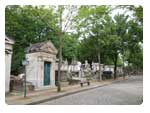
|
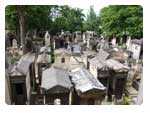
|
Ohlsdorf | ||
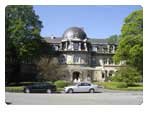
|
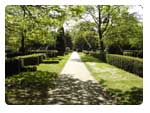
|
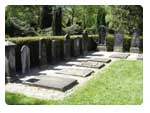
|
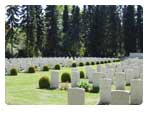
|
||
Bratislava | ||
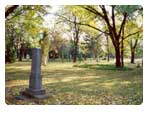
|
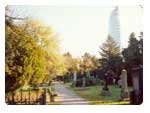
|
|
Detva | ||

|

|

|

|
||
Bratislava - Lamač | ||
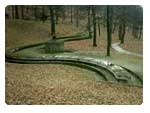
|
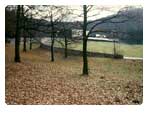
|
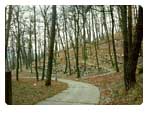
|
Bratislava - Ružinov | ||
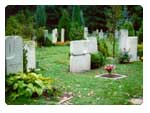
|
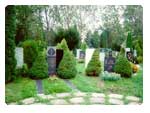
|
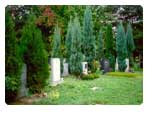
|
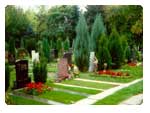
|
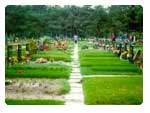
|
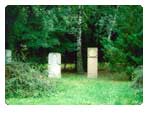
|
Neubiberg | ||
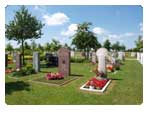
|
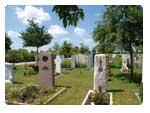
|
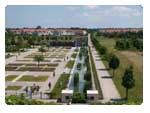
|
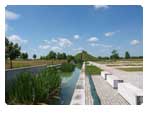
|
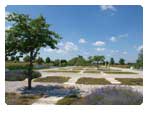
|
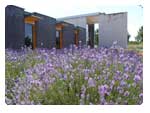
|
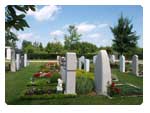
|
||
Nieuwe-Ooster | ||
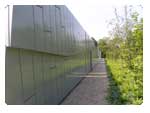
|
||
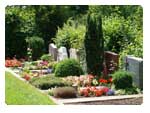
|
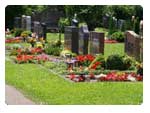
|
|

|

|
|
Author
Ing. Denisa Halajová, PhD.
Department of Horticulture and Landscape Engineering of Slovak University of Agriculture, Nitra

